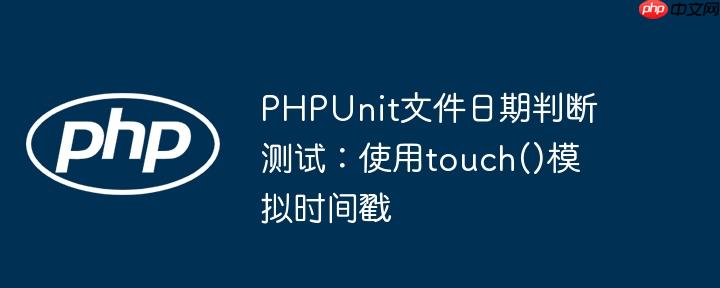
在PHPUnit测试中,当需要验证文件是否过时时,直接操作文件系统时间戳是关键。本文将详细介绍如何利用PHP内置的touch()函数精确模拟文件的修改时间,并区分filectime和filemtime,确保测试的准确性。通过实际代码示例,您将学会如何为文件设置特定日期,从而有效地测试文件日期相关的业务逻辑。
理解文件时间戳与测试挑战
在开发过程中,我们经常会遇到需要判断文件“新鲜度”的业务场景,例如缓存文件是否过期、日志文件是否需要归档等。以下是一个常见的文件年龄检查方法:
class FileService { private function checkFileOutdated(string $filePath): bool { if (file_exists($filePath)) { // 获取文件创建时间或inode修改时间 $fileTimeStamp = filectime($filePath); $now = new DateTimeImmutable(); $fileDate = new DateTimeImmutable('@' . $fileTimeStamp); $diff = (int) $now->format('Ymd') - (int) $fileDate->format('Ymd'); return $diff > 0; } return true; // 文件不存在,视为过时 } }
在为这类方法编写单元测试时,一个核心挑战是如何模拟一个“过时”的文件。直接在测试环境中等待文件自然变老显然不切实际。尝试使用系统命令 exec(‘touch -t …’) 来修改文件时间戳,虽然在终端显示成功,但在PHP代码中读取时却可能发现时间并未如预期般改变,这往往是由于对文件时间戳类型理解的偏差以及不同系统环境下命令行为的差异造成的。
PHP文件时间戳类型辨析
在PHP中,有三个主要函数用于获取文件的时间戳:
- fileatime(string $filename):获取文件的上次访问时间 (Access Time)。当文件被读取时,此时间会更新。
- filemtime(string $filename):获取文件的上次修改时间 (Modification Time)。当文件内容被写入或修改时,此时间会更新。
- filectime(string $filename):获取文件的上次inode修改时间 (Change Time)。当文件的元数据(如权限、所有者、文件名)或内容被修改时,此时间会更新。在某些文件系统上,filectime可能与filemtime表现一致,但在其他情况下,例如仅仅更改了文件权限,filectime会更新而filemtime不会。
在判断文件内容是否“过时”时,通常我们关心的是文件内容的最后一次修改时间,因此filemtime()是更准确、更常用的选择。原始代码中使用filectime()可能导致在某些系统或操作下出现不符合预期的行为。
使用PHP touch() 函数模拟文件时间
为了在单元测试中可靠地模拟文件时间戳,我们应该使用PHP内置的touch()函数,而不是依赖外部的exec()调用。touch()函数允许我们创建文件(如果不存在)并设置其访问和修改时间。
立即学习“PHP免费学习笔记(深入)”;
bool touch ( string $filename [, int $time = time() [, int $atime = time() ]] )
- $filename: 要操作的文件路径。
- $time: 可选,设置文件的修改时间(mtime),默认为当前时间。
- $atime: 可选,设置文件的访问时间(atime),默认为当前时间。
示例:创建并设置一个过时文件
以下代码演示了如何创建一个临时文件,并将其修改时间设置为昨天:
<?php // 1. 定义一个临时文件路径 $tempFilePath = sys_get_temp_dir() . '/test_outdated_file.txt'; // 2. 使用 touch() 函数设置文件的修改时间为昨天 // strtotime('-1 day') 会返回昨天的Unix时间戳 $yesterdayTimestamp = strtotime('-1 day'); touch($tempFilePath, $yesterdayTimestamp); // 3. 验证文件时间戳 echo "文件修改时间 (filemtime): " . date('Y-m-d H:i:s', filemtime($tempFilePath)) . "n"; echo "文件访问时间 (fileatime): " . date('Y-m-d H:i:s', fileatime($tempFilePath)) . "n"; echo "文件inode修改时间 (filectime): " . date('Y-m-d H:i:s', filectime($tempFilePath)) . "n"; // 输出示例 (假设当前是2023-10-27): // 文件修改时间 (filemtime): 2023-10-26 10:00:00 // 文件访问时间 (fileatime): 2023-10-26 10:00:00 // 文件inode修改时间 (filectime): 2023-10-27 10:00:00 (可能因为 touch() 操作本身导致 inode 变化) // 清理临时文件 unlink($tempFilePath); ?>
注意事项:
- touch() 函数如果文件不存在会创建它。
- filectime 可能会在 touch() 操作后更新到当前时间,因为它记录的是文件元数据(如权限、所有者、文件名等)的最后一次变更时间。而 touch() 操作本身就是对文件元数据的修改。因此,对于文件内容是否过时的判断,应始终依赖 filemtime()。
构建可测试的文件年龄判断方法
为了确保测试的准确性,我们需要将 checkFileOutdated 方法中的 filectime 替换为 filemtime。
class FileService { /** * 检查文件是否比一天前更旧。 * * @param string $filePath 文件路径。 * @return bool 如果文件存在且修改时间早于一天前,则返回 true。 * 如果文件不存在,也视为过时,返回 true。 */ private function checkFileOutdated(string $filePath): bool { if (!file_exists($filePath)) { return true; // 文件不存在,视为过时 } // 获取文件的最后修改时间 $fileModificationTime = filemtime($filePath); // 计算一天前的Unix时间戳 $oneDayAgo = strtotime('-1 day'); // 直接比较时间戳 return $fileModificationTime < $oneDayAgo; } }
PHPUnit测试案例实践
现在,我们可以编写一个PHPUnit测试来验证 checkFileOutdated 方法。
<?php use PHPUnitFrameworkTestCase; class FileServiceTest extends TestCase { private $tempFilePath; protected function setUp(): void { parent::setUp(); // 为每个测试用例生成一个唯一的临时文件路径 $this->tempFilePath = sys_get_temp_dir() . '/test_file_' . uniqid() . '.txt'; } protected function tearDown(): void { // 清理测试后创建的临时文件 if (file_exists($this->tempFilePath)) { unlink($this->tempFilePath); } parent::tearDown(); } /** * 测试一个过时的文件。 */ public function testOutdatedFile() { // 将文件修改时间设置为两天前 $twoDaysAgo = strtotime('-2 days'); touch($this->tempFilePath, $twoDaysAgo); $service = new FileService(); // 使用反射访问私有方法进行测试 $reflection = new ReflectionClass($service); $method = $reflection->getMethod('checkFileOutdated'); $method->setAccessible(true); $this->assertTrue($method->invoke($service, $this->tempFilePath)); } /** * 测试一个未过时的文件(修改时间在一天之内)。 */ public function testFreshFile() { // 将文件修改时间设置为一小时前 $oneHourAgo = strtotime('-1 hour'); touch($this->tempFilePath, $oneHourAgo); $service = new FileService(); $reflection = new ReflectionClass($service); $method = $reflection->getMethod('checkFileOutdated'); $method->setAccessible(true); $this->assertFalse($method->invoke($service, $this->tempFilePath)); } /** * 测试文件不存在的情况。 */ public function testNonExistentFile() { // 确保文件不存在 if (file_exists($this->tempFilePath)) { unlink($this->tempFilePath); } $service = new FileService(); $reflection = new ReflectionClass($service); $method = $reflection->getMethod('checkFileOutdated'); $method->setAccessible(true); $this->assertTrue($method->invoke($service, $this->tempFilePath)); } } // 假设 FileService 类已定义在同一个文件或已正确加载 class FileService { /** * 检查文件是否比一天前更旧。 * * @param string $filePath 文件路径。 * @return bool 如果文件存在且修改时间早于一天前,则返回 true。 * 如果文件不存在,也视为过时,返回 true。 */ private function checkFileOutdated(string $filePath): bool { if (!file_exists($filePath)) { return true; // 文件不存在,视为过时 } // 获取文件的最后修改时间 $fileModificationTime = filemtime($filePath); // 计算一天前的Unix时间戳 $oneDayAgo = strtotime('-1 day'); // 直接比较时间戳 return $fileModificationTime < $oneDayAgo; } } ?>
代码说明:
- setUp() 方法用于在每个测试用例开始前创建一个唯一的临时文件路径。
- tearDown() 方法用于在每个测试用例结束后清理创建的临时文件,确保测试环境的整洁。
- touch($this-youjiankuohaophpcntempFilePath, $timestamp) 用于设置文件的修改时间。
- 由于 checkFileOutdated 是私有方法,我们使用PHP的反射机制 (ReflectionClass 和 ReflectionMethod) 来访问它进行测试。在实际项目中,如果该方法是某个公共API的内部实现,通常会通过测试公共API来间接验证它。
优化日期比较逻辑
原始代码中通过 DateTimeImmutable 对象进行日期格式化和整数相减来判断日期差异,虽然可行,但较为复杂且效率略低。更简洁高效的方式是直接比较Unix时间戳。
// 原始的复杂比较方式 // $now = new DateTimeImmutable(); // $fileDate = new DateTimeImmutable('@' . $fileTimeStamp); // $diff = (int) $now->format('Ymd') - (int) $fileDate->format('Ymd'); // return $diff > 0; // 优化后的直接时间戳比较 $fileModificationTime = filemtime($filePath); $oneDayAgo = strtotime('-1 day'); // 获取一天前的Unix时间戳 return $fileModificationTime < $oneDayAgo; // 如果文件修改时间早于一天前,则为过时
这种直接比较时间戳的方法不仅代码更简洁易懂,而且避免了不必要的对象创建和格式化操作,提升了性能。
注意事项与进阶实践
- 临时文件管理:在单元测试中创建的临时文件务必在测试结束后清理。setUp() 和 tearDown() 方法是处理这一问题的最佳实践。使用 sys_get_temp_dir() 可以获取系统临时目录,确保在不同操作系统上的兼容性。
- 跨平台兼容性:touch()、filemtime() 等PHP文件系统函数在大多数操作系统(包括Alpine Linux)上行为一致。但需注意,不同文件系统(如NFS、FAT32等)对时间戳的精度和行为可能存在细微差异,但在常规的Linux文件系统(如ext4)上通常表现良好。
- 虚拟文件系统:对于更复杂的涉及文件系统操作的测试场景,可以考虑使用虚拟文件系统库,如 vfsStream。vfsStream 允许在内存中模拟整个文件系统结构,而无需实际创建文件,这使得测试更加隔离、快速和可控,并且完全不受真实文件系统行为的影响。
总结
在PHPUnit中测试文件年龄判断逻辑时,关键在于正确模拟文件的时间戳。通过本文,我们了解到:
- 应使用PHP内置的 touch() 函数来设置文件的修改时间,而非依赖外部 exec() 命令。
- 在判断文件内容是否过时时,filemtime() 是比 filectime() 更准确的选择。
- 直接比较Unix时间戳是判断文件年龄的最简洁高效的方法。
- 在测试中,务必做好临时文件的创建与清理工作,以保证测试的隔离性和环境的整洁。
掌握这些技巧,将使您能够更有效地为涉及文件时间戳的业务逻辑编写健壮的单元测试。
以上就是PHPUnit文件日期判断测试:使用touch()模拟时间戳的详细内容,更多请关注php linux node go 操作系统 access php String timestamp 对象 this linux unix Access


